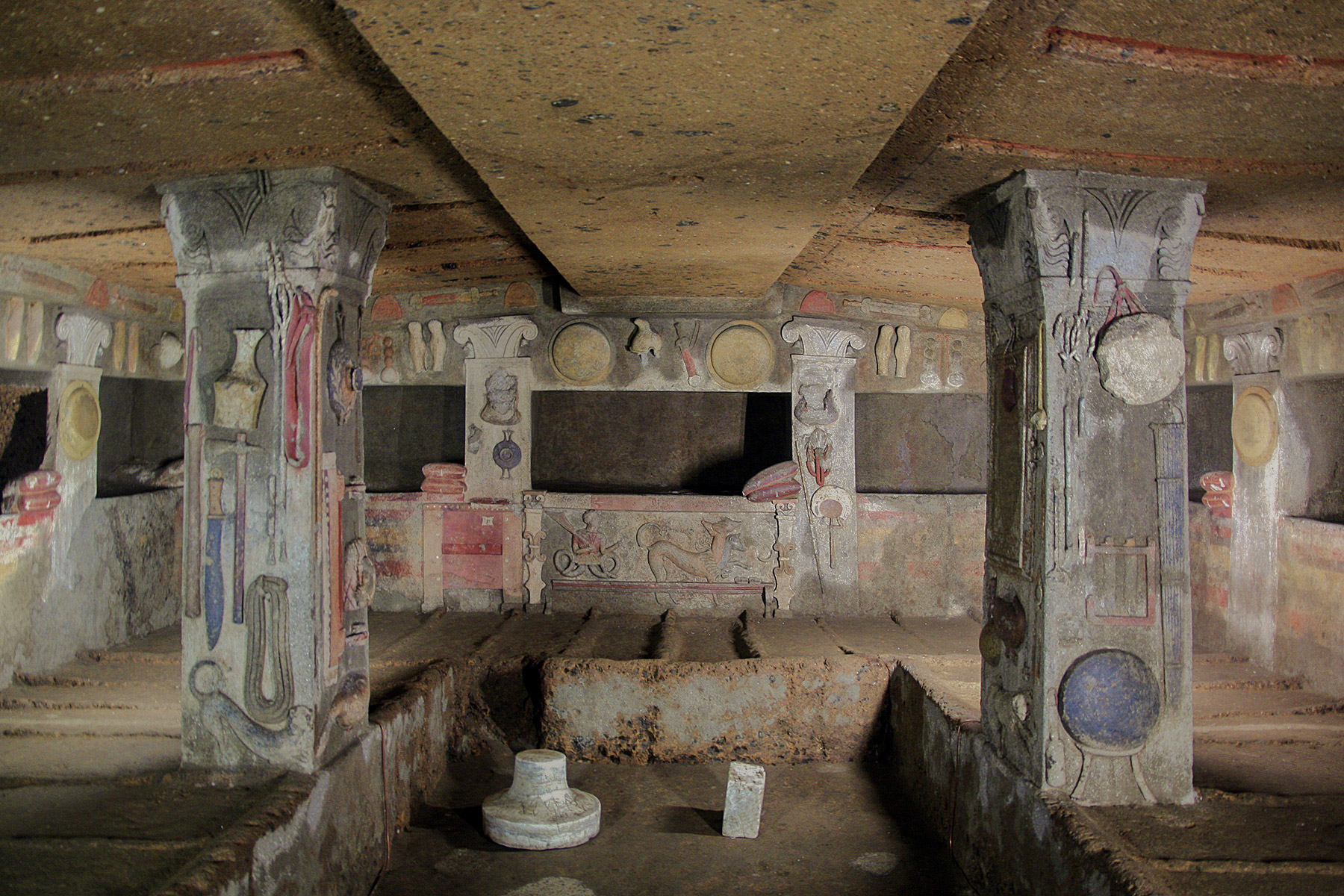Tomb of the Reliefs on:
[Wikipedia]
[Google]
[Amazon]

 The Tomb of the Reliefs ( it, Tomba dei Rilievi) is an Etruscan tomb in the Banditaccia necropolis near
The Tomb of the Reliefs ( it, Tomba dei Rilievi) is an Etruscan tomb in the Banditaccia necropolis near

 The Tomb of the Reliefs ( it, Tomba dei Rilievi) is an Etruscan tomb in the Banditaccia necropolis near
The Tomb of the Reliefs ( it, Tomba dei Rilievi) is an Etruscan tomb in the Banditaccia necropolis near Cerveteri
Cerveteri () is a town and '' comune'' of northern Lazio in the region of the Metropolitan City of Rome. Known by the ancient Romans as Caere, and previously by the Etruscans as Caisra or Cisra, and as Agylla (or ) by the Greeks, its modern na ...
, Italy
Italy ( it, Italia ), officially the Italian Republic, ) or the Republic of Italy, is a country in Southern Europe. It is located in the middle of the Mediterranean Sea, and its territory largely coincides with the homonymous geographical ...
.
It was discovered in 1847 and has been dated to the end of the 4th century BC. It is a unique example of an Etruscan tomb which is decorated with stucco
Stucco or render is a construction material made of aggregates, a binder, and water. Stucco is applied wet and hardens to a very dense solid. It is used as a decorative coating for walls and ceilings, exterior walls, and as a sculptural and a ...
relief
Relief is a sculptural method in which the sculpted pieces are bonded to a solid background of the same material. The term '' relief'' is from the Latin verb ''relevo'', to raise. To create a sculpture in relief is to give the impression that th ...
s instead of the usual fresco
Fresco (plural ''frescos'' or ''frescoes'') is a technique of mural painting executed upon freshly laid ("wet") lime plaster. Water is used as the vehicle for the dry-powder pigment to merge with the plaster, and with the setting of the plast ...
es.
Description
The tomb belonged to the Matuna family according to inscriptions inside the chamber. The rectangular chamber is entered through a steeply descending steppeddromos
Dromos may refer to:
* ''Cursus publicus'', the public road system of the Roman and Byzantine empires
* Dromos, in architecture, an entrance passage or avenue leading to a building
* Dromoi Dromoi (Greek: δρόμοι "ways"; singular: δρόμο ...
. The center of the room is surrounded by a raised platform, which is separated by low ledges into 32 spaces to depose the dead. Above these are 12 oblong niches carved in the walls, which provided space for more deceased. The niches are modeled after beds with stucco pillows. The central niche in the rear wall is deeper, which allowed for a deceased couple to be placed side by side. Below this central niche are reliefs of Kerberos and an unidentified demon from the underworld. The demon has a fish tail and wields a rudder and a serpent. Two damaged busts on the pilasters flanking the central niche possibly depict the divinities Aita
Aita (also spelled ''Eita'' in Etruscan inscriptions) is the name of the Etruscan equivalent to the Greek Hades, the god of the underworld.
Images
Aita is a relatively late addition to the Etruscan pantheon, appearing in iconography and i ...
and Persipnei.
The walls and the two freestanding pilasters are decorated with stucco reliefs of objects from daily life. These include household items, pets and other animals. Some objects symbolize the Matuna family's power as magistrates, such as an ivory folding chair, horns and a lituus
The word ''lituus'' originally meant a curved augural staff, or a curved war-trumpet in the ancient Latin language. This Latin word continued in use through the 18th century as an alternative to the vernacular names of various musical instruments ...
. Their martial prowess is shown by the various helmets, armors, shields and weapons. The decorations give a realistic impression of the interior of Etruscan houses. Because cupboards were not known, everything was hung up on walls. The only piece of furniture is a chest at the foot of the central niche in the rear wall. This might have been used to store valuables. The folded material on top of this chest might depict linen
Linen () is a textile made from the fibers of the flax plant.
Linen is very strong, absorbent, and dries faster than cotton. Because of these properties, linen is comfortable to wear in hot weather and is valued for use in garments. It also ...
used for writing, such as religious texts or family records.
References
Sources
* *External links
* Dr. Jeffrey A. Becker, "Tomb of the Reliefs," in Smarthistory, August 8, 2015, accessed June 3, 2018, https://smarthistory.org/tomb-of-the-reliefs/. {{Coord, 42, 00, 25.5, N, 12, 06, 09.2, E, region:IT-VT_type:landmark_source:kolossus-dewiki, display=title 1847 archaeological discoveriesReliefs
Relief is a sculptural method in which the sculpted pieces are bonded to a solid background of the same material. The term '' relief'' is from the Latin verb ''relevo'', to raise. To create a sculpture in relief is to give the impression that th ...
Reliefs in Italy